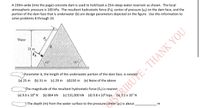
Structural Analysis
6th Edition
ISBN: 9781337630931
Author: KASSIMALI, Aslam.
Publisher: Cengage,
expand_more
expand_more
format_list_bulleted
Question

Transcribed Image Text:### Problem Set on Hydrostatic Forces on a Concrete Dam
#### Overview
A 150m-wide (into the page) concrete dam is used to hold back a 25m-deep water reservoir as shown in the diagram below. The local atmospheric pressure is 100 kPa. The resultant hydrostatic force (\(F_R\)), center of pressure (\(y_p\)) on the dam face, and the portion of the dam face that is underwater (b) are design parameters depicted in the figure. Use this information to solve problems 8 through 10.
#### Diagram Description
The diagram depicts a triangular concrete dam with the following details:
- The dam has a triangular cross-section with an apex angle of 60° on both sides.
- The height of the water reservoir is 25 meters.
- The width of the dam, which extends into the page, is 150 meters.
Key parameters labeled in the diagram include:
- Depth of water: 25 meters.
- Hydrostatic force, \(F_R\), acting at point \(y_p\) from the water surface.
- The length of the underwater portion of the dam's face, b, which needs to be determined.
#### Questions
1. **Parameter b**, the length of the underwater portion of the dam face, is nearest:
- (a) 25 m
- (b) 31 m
- (c) 29 m
- (d) 150 m
- (e) None of the above
2. **The magnitude of the resultant hydrostatic force (\(F_R\))** is nearest:
- (a) 9.6 x 10⁸ N
- (b) 864 kN
- (c) 531,000 kN
- (d) 9.8 x 10⁶ kips
- (e) 3.2 x 10⁷ N
3. **The depth (m) from the water surface to the pressure center (\(y_p\))** is about ___________ m.
Use the information in the diagram and the given options to find the correct values for the parameters asked in the questions.
Expert Solution
This question has been solved!
Explore an expertly crafted, step-by-step solution for a thorough understanding of key concepts.
This is a popular solution
Trending nowThis is a popular solution!
Step by stepSolved in 3 steps with 6 images

Knowledge Booster
Learn more about
Need a deep-dive on the concept behind this application? Look no further. Learn more about this topic, civil-engineering and related others by exploring similar questions and additional content below.Similar questions
- 7arrow_forwardI need the answer as soon as possiblearrow_forwardFor the below figure, find pressure head, total head, and datum head at point A. Assume velocity head is zero. 5 m 3 m A 2 m 3 m 2 m datum Options: (A)Pressure head%-D1.2 m, datum head-2 m, total head-3.2 m (B) Pressure head-3.8 m, datum head-2 m, total head-5.8 m (C) Pressure head%3.8 m, datum head-D1 m, total head-2.8 m (D)Pressure head-1.2 m, datum head-3 m, total head-1.8 m Answer REDMI K20 PRO 000 AI TRIPLE CAMERAarrow_forward
arrow_back_ios
arrow_forward_ios
Recommended textbooks for you

 Structural Analysis (10th Edition)Civil EngineeringISBN:9780134610672Author:Russell C. HibbelerPublisher:PEARSON
Structural Analysis (10th Edition)Civil EngineeringISBN:9780134610672Author:Russell C. HibbelerPublisher:PEARSON Principles of Foundation Engineering (MindTap Cou...Civil EngineeringISBN:9781337705028Author:Braja M. Das, Nagaratnam SivakuganPublisher:Cengage Learning
Principles of Foundation Engineering (MindTap Cou...Civil EngineeringISBN:9781337705028Author:Braja M. Das, Nagaratnam SivakuganPublisher:Cengage Learning Fundamentals of Structural AnalysisCivil EngineeringISBN:9780073398006Author:Kenneth M. Leet Emeritus, Chia-Ming Uang, Joel LanningPublisher:McGraw-Hill Education
Fundamentals of Structural AnalysisCivil EngineeringISBN:9780073398006Author:Kenneth M. Leet Emeritus, Chia-Ming Uang, Joel LanningPublisher:McGraw-Hill Education
 Traffic and Highway EngineeringCivil EngineeringISBN:9781305156241Author:Garber, Nicholas J.Publisher:Cengage Learning
Traffic and Highway EngineeringCivil EngineeringISBN:9781305156241Author:Garber, Nicholas J.Publisher:Cengage Learning


Structural Analysis (10th Edition)
Civil Engineering
ISBN:9780134610672
Author:Russell C. Hibbeler
Publisher:PEARSON

Principles of Foundation Engineering (MindTap Cou...
Civil Engineering
ISBN:9781337705028
Author:Braja M. Das, Nagaratnam Sivakugan
Publisher:Cengage Learning

Fundamentals of Structural Analysis
Civil Engineering
ISBN:9780073398006
Author:Kenneth M. Leet Emeritus, Chia-Ming Uang, Joel Lanning
Publisher:McGraw-Hill Education


Traffic and Highway Engineering
Civil Engineering
ISBN:9781305156241
Author:Garber, Nicholas J.
Publisher:Cengage Learning